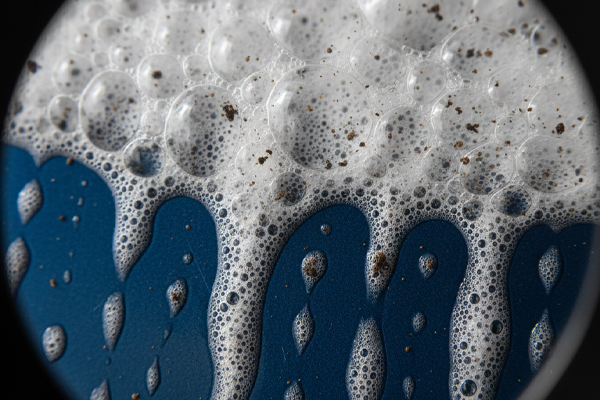You look at your dirty car and sigh, thinking about the long, wet chore ahead. The thought of dragging out buckets, sloshing water, and scrubbing for an hour makes you want to put it off.
Yes, using a foam sprayer is significantly better than a traditional hand wash. It is much faster, more efficient with water, and safer for your car's paint because the foam pre-soaks and lifts dirt before you start scrubbing.

In my 15 years of making cleaning tools, the goal has always been to find a better, smarter way to get things done. The traditional bucket-and-sponge car wash is a perfect example of a process that was begging for improvement. It's a method born from a time before we had access to better technology. While it can get a car clean, it's inefficient and carries risks that most people don't even think about. Let’s break down the old way to truly appreciate the new way.
What makes the old bucket and sponge method so slow?
You know the routine, it’s the way we’ve always been taught to wash a car. But when you look at each step, you realize how much time is wasted on inefficient tasks.
The traditional bucket wash1 is slow because it involves many separate, manual steps. You have to haul water, manually wet the car, wash, and then manually rinse, often needing to refill the bucket in the middle of the process.

Let’s walk through the classic hand wash process together. First, you find a bucket, take it to your tap, and fill it with water. Then you have to carry that heavy, sloshing bucket over to your car without spilling it. Next, you add your detergent. Now the car is still dry, so you have to start scooping water out with a container or sponge to wet the entire vehicle, panel by panel. Only then can you begin the actual scrubbing. Once you're done scrubbing, the rinsing process begins, which again involves scooping clear water onto the car until the soap is gone. If you run out of water, which is common, you have to stop everything and go repeat the whole process of filling and carrying the bucket again. Each step is disconnected, requiring you to stop and start constantly. It’s no wonder this entire process can easily take up an hour.
The Traditional Hand Wash Workflow
| Step | Action | Time & Effort |
|---|---|---|
| 1. Preparation | Find, fill, and carry a heavy water bucket. | High effort, takes several minutes. |
| 2. Wetting | Manually scoop water to wet the car's surface. | Inefficient and slow. |
| 3. Washing | Scrub the entire vehicle with a mitt or sponge. | The core cleaning task. |
| 4. Rinsing | Manually scoop clean water to rinse off soap. | Slow, often requires a second bucket. |
| Total Time | Approximately 1 hour. |
How does a foam sprayer completely change the process?
You want a process that is simple, connected, and fast. You want to get the job done properly without dedicating your entire afternoon to it, using one tool from start to finish.
A foam sprayer2 streamlines the entire car wash into a single, continuous process. It connects directly to your hose, allowing you to seamlessly switch between applying thick foam and rinsing with clear water, cutting the total time to just 15 minutes.

Now, let's look at the modern workflow using a low-pressure foam sprayer3r](https://www.reddit.com/r/AutoDetailing/comments/15pges8/what_is_the_actual_practical_application_of_a/)%%%FOOTNOTE_REF_2%%%. The first and only preparation step is to connect your garden hose to the foam sprayer. You then pour a little car wash soap4 into the sprayer's canister and add some water. That’s it; you are ready to go. You turn on the water and spray the entire car with a thick layer of cleaning foam5 in about two minutes. The foam immediately starts to loosen and lift the dirt. After letting it sit for a moment, you use a wash mitt to wipe down the whole car. Once you're done wiping, you simply turn a dial on the sprayer to the clear water setting. Now, you use the same tool to rinse the entire car clean. There’s no running back and forth, no carrying buckets, and no wasted motion. The entire job, from start to finish, is done in about 15 minutes.
Is the final result actually better and safer for your car?
You might think that a faster wash is a less thorough wash. You worry that by saving time, you might be cutting corners and not getting the car as clean, or worse, even damaging it.
Yes, the foam sprayer method is not only faster but also safer for your car. The thick foam acts as a pre-soak, loosening abrasive dirt and grit so you're not grinding it into the paint when you start scrubbing. This dramatically reduces the risk of swirl marks and fine scratches.

This is the most important advantage, and it’s something we focused on heavily during development. With the bucket method, you often apply your soapy sponge directly to a dry, dirty surface. This means you are immediately rubbing sharp particles of dirt and grit across your car's clear coat, which is the primary cause of swirl marks6. A foam sprayer completely avoids this. The foam is applied first, and it clings to the surface. It soaks and encapsulates the dirt particles7, lifting them away from the paint. By the time your wash mitt touches the car, the most abrasive dirt has already been loosened and is suspended in the foam, not stuck to the surface. This makes the physical washing step far gentler and safer for your paint. So, you aren't just saving time; you are actively preserving the quality and finish of your car's paintwork.
Conclusion
A foam sprayer is better than a traditional hand wash. It delivers a faster, more efficient, and safer cleaning process that protects your car's finish while saving you valuable time and effort.
Learn about the drawbacks of the bucket wash method and how it compares to modern techniques. ↩
Discover how foam sprayers enhance car cleaning efficiency and protect your vehicle's paint. ↩
Learn about the advantages of using a low-pressure foam sprayer for car washing. ↩
Explore the best car wash soaps that work effectively with foam sprayers for optimal results. ↩
Find out how cleaning foam helps in loosening dirt and protecting your car's surface. ↩
Understand the causes of swirl marks and how to prevent them during car washing. ↩
Understand the impact of dirt particles on your car's paint and how to mitigate damage. ↩
